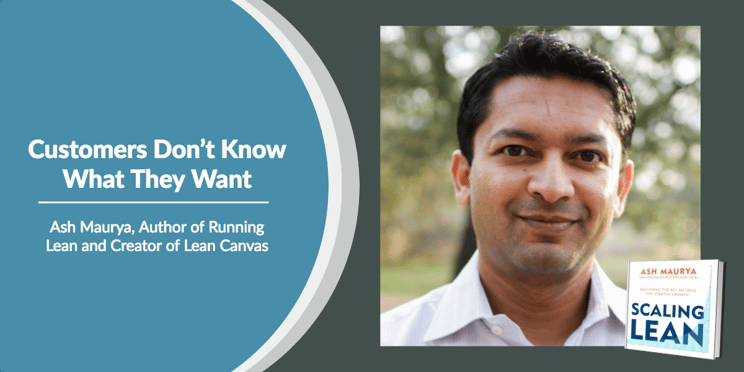
I had the fortunate experience of attending both of Ash Maurya’s workshops - Lean Startup and Lean Canvas back in 2014. The insights, experiences and practical methods of application have stuck with me ever since and have been guiding forces throughout the launch of our technology Ving! To this day, his book sits with pages tattered and marked with Post-it notes on my desk.
When we launched our guest blog series I set my sights high, looking for only tier one thought leaders to participate. His name immediately surfaced. I was so pleased he replied, Yes! He’d participate.
I’m psyched to welcome Ash Maurya to our guest blog series!
- Tony DeAscentis, Ving CEO
------
We pay a lot of lip service to talking to customers. After all, the customer is always right. But simply asking customers what they want is asking to go on a wild goose chase.
In my last company, WiredReach, I ran numerous surveys, ranked my results, and prioritized building what customers said was important to them. But even after all that work, my conversion rate to paid customers remained flat.
Why was I repeatedly missing the mark on what customers really wanted?
Are Customers Visionary Enough?
A number of my advisers cited this (mis-attributed) Henry Ford quote as the reason it’s hopeless to talk to customers.
“If I had asked people what they wanted, they would have said faster horses.”
—Henry Ford
They told me customers weren’t visionary enough. However, over the years I’ve learned this is only partially accurate.
The Customer’s Job
“It is not the customer’s job to know what they want.”
—Steve Jobs
Steve Jobs nailed it when he said it is not the customer’s job, but our jobs as innovators, to know what customers really want.
The way you uncover this is not by running a bunch of surveys or focus groups, or asking your customers for feature ideas or solutions, but rather by deeply immersing yourself in your customer’s world and understanding their problems.
Love the Problem, Not the Solution
We are all biased by our solutions — including your customers. Until you truly understand the problem, most solutions only scratch surface issues and don’t stick beyond the initial enthusiasm for something new.
We need to change our approach. We need to think in terms of customer problems and jobs, versus features and benefits of our pre-conceived solutions.
Specifically, we need to spend more time understanding:
- What jobs are our customers trying to get done?
- Are they succeeding or failing at these jobs?
- And if they are failing, why?
Therein lie the problems and space for innovation.
The Henry Ford Quote Revisited
Even hidden in the Henry Ford quote above is a customer problem statement. Had customers really said they wanted “faster horses”, they would really have been asking for something faster than their existing alternative (the horse drawn carriage).
Henry Ford could have taken this literally and explored genetic engineering for faster horses. But he instead chose to mass produce the automobile — allowing his customers to fire the horse drawn carriage and hire the better suited automobile for the job at hand.
Given the right context, customers can clearly articulate their problems, but it’s your job to come up with the solution.
About the Author: Ash Maurya is the author of the best-selling book Running Lean and creator of the 1-page business model format Lean Canvas. His next book, Scaling Lean, hits the bookshelf on June 14th, 2016.





Leave a Comment